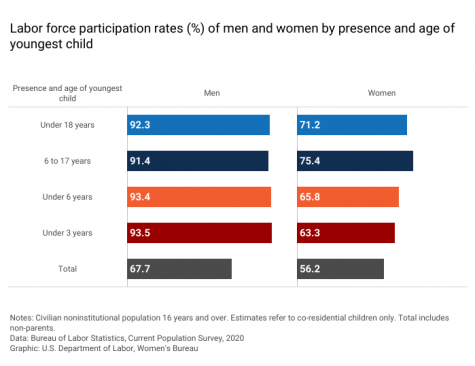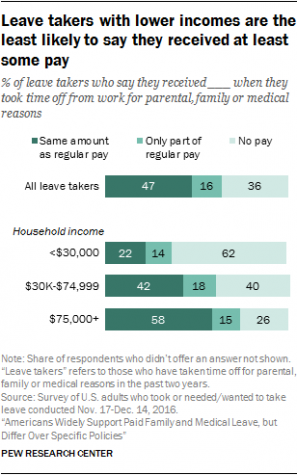
Sophie Lu is a senior at NASH. She loves reading, writing, travel, and binging The Office while eating copious amounts of purple Doritos. Outside of The Uproar, she is a member of Speech and Debate, DECA, and orchestra.
November 17, 2021
Marshall Islands, the Federated States of Micronesia, Nauru, Palau, Papua New Guinea, Tonga, and the United States of America. These seven are the only countries in the world that do not provide guaranteed parental leave. Among its much smaller and less industrialized fellow list-members, the United States’ lack of protections for new parents stands out starkly, alone amongst wealthy, developed nations. And the US needs to get off of that list as soon as possible.
The vitality of paid leave is well documented and immense. Studies show that paid leave improves health (both of the infant and parent), families’ financial security, and employee retention, productivity, and labor force participation. It is especially significant considering women provide the main source of income in 30% of all households worldwide. 59% of working European women supply half or more of their family’s household income; in the United States it is 55%.
As countries develop, more women will enter the workforce and be directly affected by the lack of paid parental leave. In 1998, the International Labour Organization (ILO) projected that in just over ten years, 80% of all women in industrialized countries and 70% globally would be working outside the home throughout their child-bearing years. The recent US Bureau of Labor Statistics data reflects this uptick (though the pandemic disproportionately saw women leaving the workforce), with 71.2% of mothers with children under 18 working.

There is simply no excuse for a country that heralds as the leader of the free world to lag so far behind in this regard. When nearly every other country (yes, that includes North Korea) manages to provide some form of federally guaranteed paid leave, there are scarcely any extenuating circumstances unique to the US that can be scapegoated. The Czech Republic leads in length provided at 28 weeks. Denmark, Norway, and Sweden all provide extensive paid leave that may be taken by either parent, though a portion is reserved for the mother.
While several states and some local policies form patchy coverage of paid parental leave in some areas, the lack of federal oversight has left millions of new parents behind. This particularly impacts women, who are primarily the ones who leave their jobs temporarily to care for their children, as well as low-income families and people of color, who disproportionately lack access to benefits from employers and have less options when it comes to childcare.

With all of this, it came as even more of a disappointment when paid family leave was dropped from the marching list of President Biden’s “Build Back Better” plan. The provision was originally 12 weeks of paid leave, then reduced to 4 weeks, and now seemingly abandoned altogether. With universal Republican opposition, the Democrats in the Senate could not afford resistance from Senator Joe Manchin (D) of West Virginia, who still had reservations about the bill’s $3.5 trillion cost.
The bill was already slashed down from an initial $6 trillion proposal to appease Sen. Manchin and his fellow moderate, Krysten Sinema (D) of Arizona. Despite numerous senators, politicians, and even Meghan Markle, the Duchess of Sussex, calling for reconsideration, Manchin remained firm in his refusal. The new package without paid leave totals around $1.75 trillion.
Besides the overall cost of the plan, Manchin and other opposers’ bring up the effect of paid leave on small businesses, arguing that they are not able to afford the cost of replacing employees. However, data shows that paid leave can actually benefit small businesses. Karen White, former director for the Rutgers Center for Women and Work In New Jersey, stated that in New Jersey, workers with paid leave protections had higher morale and productivity, and businesses experienced significantly lower turnover. A study conducted in 2012 by the Center for Women and Work at Rutgers showed that parents who received paid leave were more likely to remain employed a year after childbirth.
Even if it doesn’t seem intuitive that paid leave actually benefits businesses, in principle this makes sense due to one main factor: investment in employees. When businesses take measures to ensure their employees’ wellbeing, they get staff that are healthier, more equipped to work, and more attached to their place of work. In essence, it’s not counterintuitive at all that when people are treated fairly and decently, they won’t be as primed to jump ship at the first sign of trouble.
Furthermore, paid leave is shown not just to benefit employers on a microeconomic level; it also helps the economy as a whole. It enables parents, particularly women, to remain economically active even during parenthood. The OECD reported in 2015 that equalizing men and women’s labor force participation by 2030 would result in a 12% boost to GDP across high income countries, the equivalent of $2.64 trillion per year in the US. Essentially, paid leave pays for itself in the long run.
The case for paid leave is rock solid: it is essential for the health of workers and their children, it facilitates closing the gap between men and women in the workplace, it mitigates the income disparity in childcare, and it benefits the economy as a whole. However, even though paid leave is absolutely necessary and long overdue for the US to implement, it doesn’t go far enough when it comes to supporting parents.

Sophie Lu is a senior at NASH. She loves reading, writing, travel, and binging The Office while eating copious amounts of purple Doritos. Outside of The Uproar, she is a member of Speech and Debate, DECA, and orchestra.